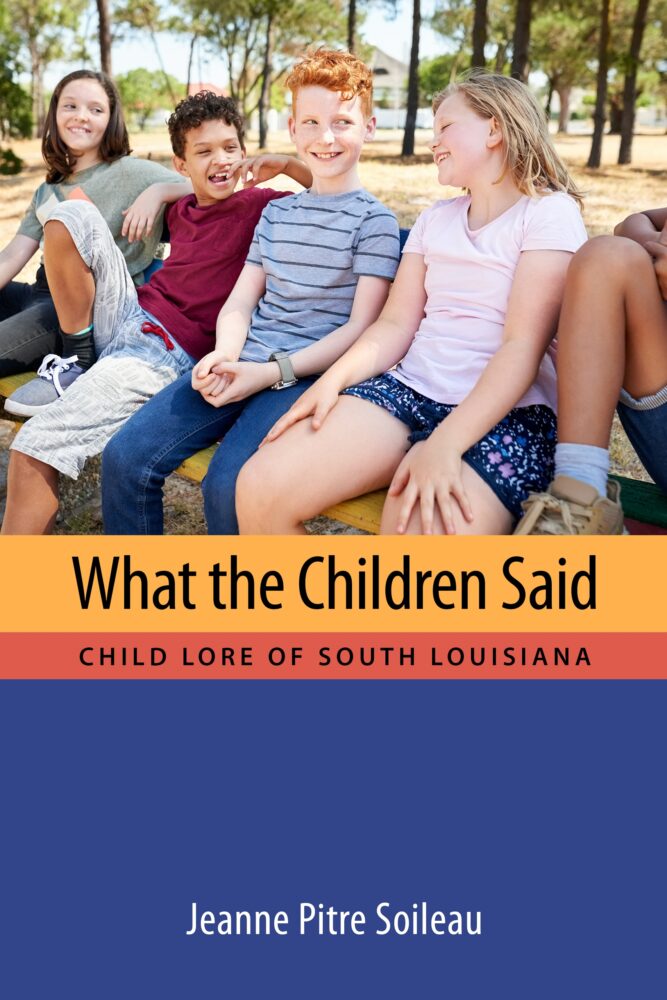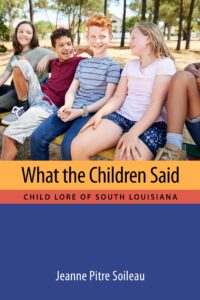Children Still Play
What the Children Said: Child Lore of South Louisiana
Published: February 28, 2022
Last Updated: May 31, 2022

University of Mississippi Press
For anyone wondering whether or not children have changed over time, What the Children Said: Child Lore of South Louisiana by Jeanne Pitre Soileau provides an answer. In the preface to her book, she explains her work as a self-described children’s folklorist: “I gather together groups of children and ask them a series of questions.” For five decades, she frequented schools, camps, and playgrounds to find out what children play and how they talk about it. In 1979, early in her career, a skeptical teacher commented to her, “I don’t think you’re going to get much from these kids. You know, children don’t play any more.” Quite to the contrary, the children were eager to share. A typical data-collecting session lasted ninety minutes. From her research, Soileau draws this conclusion: “It seems that children in south Louisiana were playing in the 1970s, and are still playing well into the twenty-first century, whenever they have the chance.”
Conversational and personable, What the Children Said ushers readers into Soileau’s lifelong sojourn through child lore, hearing the children’s chatter and visualizing the children’s actions. Some childhood chants documented in the book hearken back to the 1920s, as Soileau refers to her mother’s reported childhood memories and to her own recollections of games she played in the 1940s. Buried in a delightful footnote is the author’s story of how her collecting began. When she was teaching at Louisiana State University in 1973, she answered an ad to gather reminisces from businessmen for a bicentennial folklore enterprise. En route daily to LSU, Soileau passed schools and watched children playing handclaps, which seemed a whole lot of fun. She asked her mentor if she could collect schoolyard lore instead, and given the go-ahead, her life’s work began.
Although Soileau was flexible in her questioning, typical questions she posed to children include: “How do you choose who is ‘it’? What kind of hand-clapping games to you play? Do you play ring games? What tag games (or running games) do you play? Can you tell me a joke? What do you say to tease someone?” The book comprises transcripts of interviews with small groups of children, who share the varied versions of more than six hundred examples of lore across time, age levels, genders, and sites across South Louisiana. A map facing the title page firmly delineates the triangle of Louisiana where she interviewed her informants. Soileau counted 290 contributions from African American children and 360 from white children and adults. Claims that “we made it all up” is a common thread among children sharing lore, but in fact, almost word for word, their chants echo those of school children from the British Isles to New Zealand.
This book tells not only what children said about their games but how they said it—sometimes eloquently stated and logical, others stammering and with logical lapses. As the book is sensibly organized by type of game, rather than by chronology, attribution is not always immediately clear in terms of the year she collected it. A minor quibble. Soileau does not comment on or judge children’s words but lets them speak for themselves. The data of this carefully wrought research project—that is, the treasure trove of the children’s words—enables readers to draw their own conclusions. Readers may well be surprised or even shocked by the sexual nature and outright racism that emerges. Not that Soileau didn’t provide a warning: along with many other insights in the introduction and analysis at the ends of chapters, she shares that children across age and sex not only learned racism and sexism early but also were willing, as young as seven or eight, to be recorded using pejorative names and slurs. Once finished with the book, readers will want to reread the introduction, a real nugget in the treasure trove.
The “Just for Fun” sections at the end of most chapters are indeed just that—fun. Soileau admits that no words capture the games as much as observing children; thus she invites readers to tune in to YouTube videos that she perused. Partaking in such videos will add to the reader’s pleasure. “And, hey,” Soileau encourages us, “you might want to video yourself and your friends skipping rope to a chant you’d like to share.”
Her comprehensive list of works cited includes more than 250 sources, an amazing resource especially for fellow folklorists. Copious notes, organized by chapter, enable readers to dig deeper as Soileau acknowledges academic sources she found particularly valuable. An appendix includes an annotated list of her sixty-two collection sites. The invaluable list of school sites acknowledges when schools closed after Hurricane Katrina. As well as a short general index, Soileau includes an index of first lines and titles of the myriad games and play she recorded.
After spending so many years in the company of children, Soileau posed to herself the oft-asked question of fellow folklorists: what to call children as a group. In the end, she concurred with and quoted the renowned folklorist Iona Opie: “They always call themselves ‘people’ never ‘children.’”
As she watched and listened to them, she drew this key point: “Children . . . are quite good at teaching one another,” and their network has only grown wider through the internet. Her final words of advice bear repeating: “I have learned that children will gladly share their lore with adults who are attentive. I have also learned that if we really want to know what the children say, it is best to listen closely while the children play.”
Besides folklorists, this delightful resource will find an audience with linguists, sociologists, anthropologists, teachers, and researchers. Self-effacing and honest to a fault as a researcher, Soileau states, “Sometimes I talked too much. Sometimes I barreled on and missed an opportunity to draw certain speakers out more. Reading the transcripts could help future interviewers to avoid my mistakes.” Another viable audience is writers for children who need the language of young people ringing in their ears.
Soileau, a long-time educator with a doctorate in English/folklore, also authored Yo’Mama, Mary Mack, and Boudreaux and Thibodeaux: Louisiana Children’s Folklore and Play, recipient of both the 2018 Chicago Folklore Prize and the 2018 Opie Prize. She has triumphed again with What the Children Said: Child Lore of South Louisiana.
